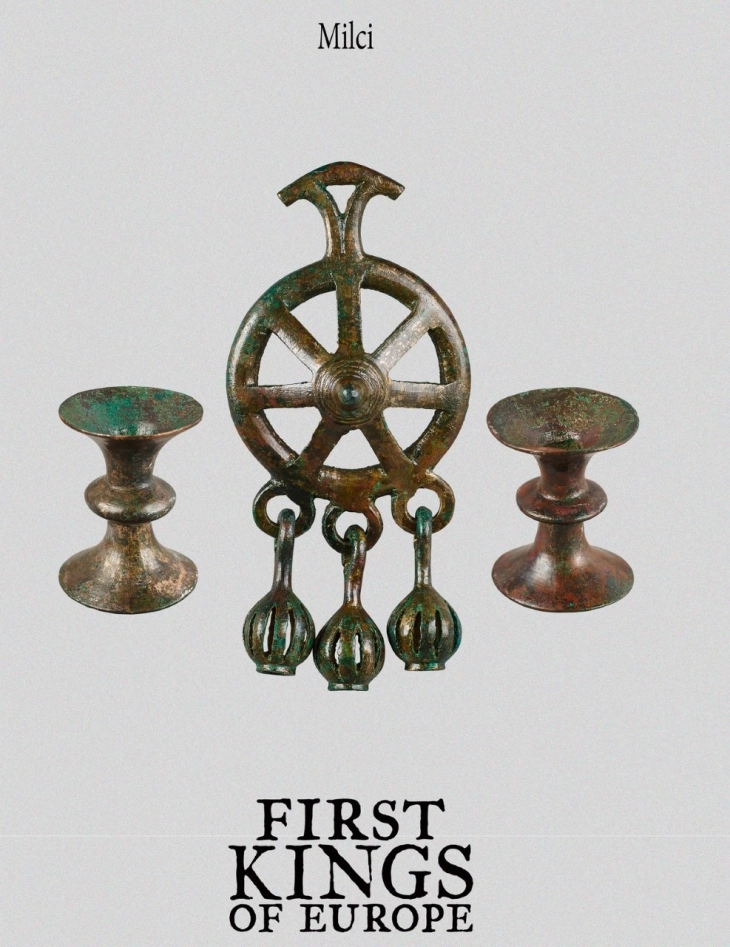Macedonian archeological items, including scepter and sacrificial altar, displayed at New York ‘First Kings of Europe’ exhibition

Bitola, 24 September 2022 (MIA) – Twelve Macedonian archeological royal items dating back to 6000 BC, will be displayed at the “First Kings of Europe” international exhibition, which opened this past Wednesday at the Institute for the Study of the Ancient World in New York.
The royal items and insignia found at the archeological sites of Milci near Gevgelija, Vrbjanska Chuka in Prilep and Shuplevec, in the Bitola part of Mariovo, provide evidence for the region during the prehistoric period, for its rich spiritual and cultural life, for the social and religious aspects of its prehistoric communities.
“First Kings of Europe” exhibitions in New York, Chicago and Ottawa
The “First Kings of Europe” exhibition is the largest exhibition on Balkan prehistoric findings and it unites several European museums. The exhibition is an initiative of the Field Museum from Chicago, which in 2018 suggested that as many museums from the Balkans participate as possible, in order to present what is connected to and key for the Balkan’s prehistoric period, i.e., the transition from tribal communities to kingdoms.
Besides the Field Museum as a host, 26 museums from 11 Balkan countries are also participating in the exhibition. During a three-year period, they will enable more than one million visitors to see the exhibition and for the first time get introduced to the social and religious aspects of prehistoric communities.
The idea for the exhibition is to show how the agricultural communities, which appeared towards the end of the seventh millennium BC, gradually, through various economic processes entered a new domain of social organization – the kingdom.
“The exhibition begins on September 21, the objects will be displayed at the New York University for six months, then in 2023 it will spend six months at the Field Museum in Chicago, while in 2024 the exhibition will be held in the Canadian Museum of History in Ottawa,” said Dr. Goce Naumov, archeologist and national coordinator of the “First Kings of Europe” project.
Sceptre of the Kneginja of Milci from 7th century BC.
The archeological site of Milci, near the village of Bogorodica in Gevgelija is a necropolis in which more than 140 intact burial sites have been discovered and explored.
Grave 111 is the so-called grave of the Kneginja, or the Princess of Milci, said Boban Husenovski, councilor at the Gevgelija Museum.
“For the first time, in this grave we managed to discover a scepter near the remains, which is connected to a historical source by Maximus of Tyre, rhetorician and philosopher, who claimed that the Paeonians carried a scepter with the symbol of the sun. This means that here we have a direct confirmation of a historical source which is something very rare in archeology. With the discovery of the Kneginja of Milci we have contact with a historical source and this undoubtedly gives significance to the discovery itself and to the exhibition with the uncompromising title of ‘First Kings of Europe’,” said Husenovski.
Sacrificial altar from 5700 BC, found in Vrbjanska Cuka
The archeological site of Vrbjanska Chuka dates back 8000 years, and is one of the rare sites in Europe in which a sacrificial altar has been found.
“We are participating in the exhibition with an object testifying to the rich spiritual life of this region. The sacrificial altar has been discovered at the Vrbjanska Chuka neolithic settlement. It has been processed and will adequately represent the period of spiritual and cultural life in the settlement,” said Gorancho Cvetkoski, head of the Prilep Museum.
Scepter – a cavalry object found in the Shuplevec archeological site
Shuplevec is a rocky region, a rare site in Mariovo, near the village of Makovo. During archeological diggings in 1954, a royal scepter was discovered, and now it will be one of the 19 Macedonian archeological objects displayed at the exhibition.
“The stone scepter dates back to the Neolithic period, and it is evidence for the cultural influences from the North. It represents the cavalry from the Caucasian regions from the first neolithic migrations in the region. The object was found in a burial site,” said Jasmina Gulevska, curator of the prehistoric collection at the Bitola Museum.
The National Institute and Museum holds the permit for the transfer of the objects from North Macedonia to the international exhibition in New York, Chicago and Ottawa.
“We expect that Macedonians from the diaspora, those living in the US and Canada can see the exhibition and maybe for the first time get acquainted with the prehistoric heritage of the region,” said Dr. Meri Stojanova, head of Institute and Museum – Bitola.
Marjan Tanushevski Translated by Angel Dimoski






